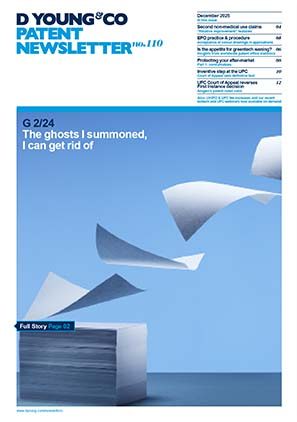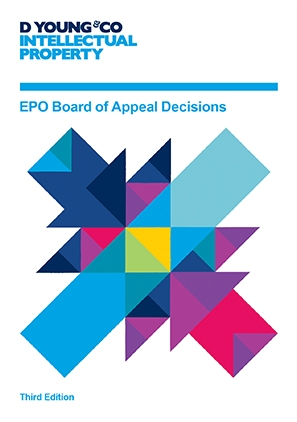EPO Guidelines for Examination: adaptation of the description to the claims
In March 2022 the European Patent Office (EPO) updated its Guidelines for Examination. This included additional detail relating to the requirement of adapting the description in line with amended claims. Of relevance to this is whether the European Patent Convention (EPC) provides legal basis for such a requirement, a topic of many recent decisions of the Boards of Appeal. In this article we summarise the recent developments in this area, as well as the changes to the updated guidelines.
Legal basis for adapting the description
In T 1989/18, which published in December 2021, the Board of Appeal decided that the EPC did not provide legal basis for requiring that the description be amended in line with allowable claims. However, since then it has become clear that the EPO considers T 1989/18 to be an isolated decision that will not be followed, despite more recent developments in case law.
T 1024/18 & T 1989/18
From March to May 2022 there were a number of decisions that supported the EPO’s view that Article 84 EPC provides legal basis for the requirement to adapt the description.Of particular note was T 1024/18, which explicitly diverged from T 1989/18. T 1024/18 interpreted the need in Article 84 EPC for the claims to be “supported by the description”, as the description being consistent with the claims “not only in some part but throughout”.
T 1444/20
However, amongst these more recent decisions is T 1444/20. This decision supported the general principle of T 1989/18: that description amendments are unnecessary if the claims are clear in and of themselves. Although the facts of each case differed slightly, in that T 1444/20 focused on the deletion of claim-like clauses and T 1989/18 related to embodiments in the description being broader than the amended claims. Of particular note is that the legal member of the Boards of Appeal in both decisions was the same.
After recognising that there was a need for greater certainty regarding the requirement to adapt the description an expert workshop was held in June 2022. This expert workshop confirmed what the EPO considers to be the established practice: that Article 84 EPC requires that inconsistencies between the claims and the description be removed. This was further justified as being in line with the standard of claim interpretation for national proceedings as per Article 69 EPC. In other words, the EPO considers the support requirement of Article 84 EPC to ensure legal certainty for national post-grant proceedings. The findings of this workshop will be used to refine next year’s guidelines.
In summary, it would seem that we might expect the requirement for adapting the description to amended claims to persist.
The conflicting decisions of T 1989/18 and T 1444/20 raise the question of whether a referral to the Enlarged Board of Appeal is imminent, so it will be interesting to see how the case law develops over the coming months and years.
2022 Guideline updates
Section F-IV, 4.3, “Inconsistencies”, of the 2022 Guidelines for Examination has been updated by the EPO to provide additional guidance and examples as to what examiners are likely to consider an inconsistency between the description and the claims. The updated guidelines should therefore assist applicants when considering amendments to the description.
An inconsistency is now defined as something that could throw doubt on the subject-matter for which protection is sought, thus making the claims unclear or unsupported.
For example, parts of the description that give the skilled person the impression that they disclose ways to carry out the invention, but are not encompassed by the wording of the claims, are considered inconsistent with the claims.
According to the updated guidelines an inconsistency arises when, for example, an alternative to a claimed feature is present in the description with a broader or different meaning, or indeed when a feature in an embodiment in the description is demonstrably incompatible with an independent claim. The description must also be amended to remove terms that refer to a mandatory feature of an independent claim as being optional.
As before, such inconsistent subject-matter must be deleted from the description or marked accordingly. Notably, the latter is now considered an equally valid option, whereas previously the guidelines indicated that this was only acceptable where the embodiment could reasonably be considered useful for highlighting specific aspects of the amended claims.
The updated guidelines also provide helpful examples of what is not considered an inconsistency. For example, an embodiment in the description comprising further features not present in the claims but encompassed by the subject-matter of an independent claim is not considered inconsistent. Further, if an embodiment in the description fails to explicitly mention one or more features of an independent claim, this is not considered inconsistent if the features are implicit or present by reference to another embodiment.
Of note is that for borderline cases, where there is genuine doubt as to whether an embodiment is consistent with the claims (not just a disagreement between applicant and examiner), the benefit of the doubt will be given to the applicant.
Of further note is that before refusing an application, due to an inconsistency between the description and the claims, the examiners must provide at least one example of such an inconsistency. Indeed, if the inconsistency concerns describing a mandatory feature of an independent claim as optional in the description, the examiners should provide an example passage in the description where this inconsistency is present.
The updated guidelines further elaborate on what examiners consider acceptable methods of marking inconsistent subject-matter. Generic disclaimers (for example, statements such as “embodiments not falling under the scope of the appended claims are to be considered merely as examples suitable for understanding the invention”) that are introduced into the beginning of the description without indicating which parts of the description they specifically refer to are not allowed.
Similarly, it is not acceptable to merely replace words such as “embodiment” or “invention” with terms such as “disclosure” or “example”. The EPO considers that, because this wording is not used consistently by the Boards of Appeal, it is not clear whether the subject-matter is excluded or not.
As before, claim-like clauses must be deleted or amended to avoid claim-like language. The updated guidelines provide further explanation on what constitutes a claim-like clause. In brief, claim-like clauses are clauses in the description which, despite not being labelled as a claim, appear as such.
In T 1444/20, the Board of Appeal considered the Examining Division’s decision to refuse an application due to the presence of claim-like clauses in the description. The Board of Appeal held that even though the claim-like clauses in question were described as “specific embodiments of the invention” they could not be mistaken for claims, since it was clear they were part of the description. Furthermore, there was no reason why having such clauses in the description would affect the clarity of the claims. Thus, T 1444/20 does not appear to align with the present guidelines.
In this regard, the Board of Appeal added that the Guidelines for Examination themselves were inconsistent, in that they acknowledge that claim-like clauses may (and therefore may not) give rise to a lack of clarity, but also require that such claim-like clauses always be removed. It will be interesting to see how the next round of guideline updates may address this point.
In summary, the updated guidelines provide clarification and further examples that should assist applicants when considering amendments to the description.



